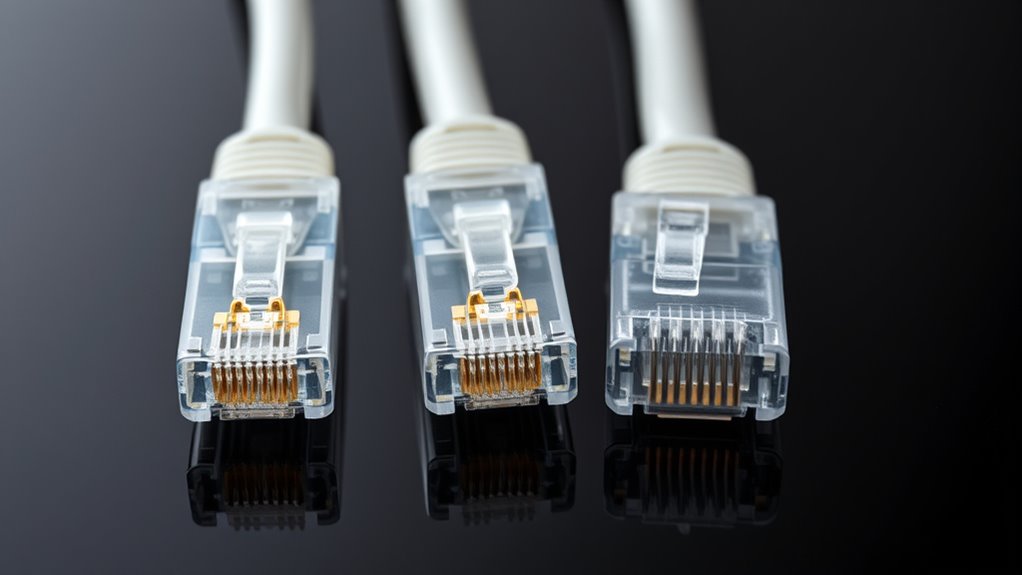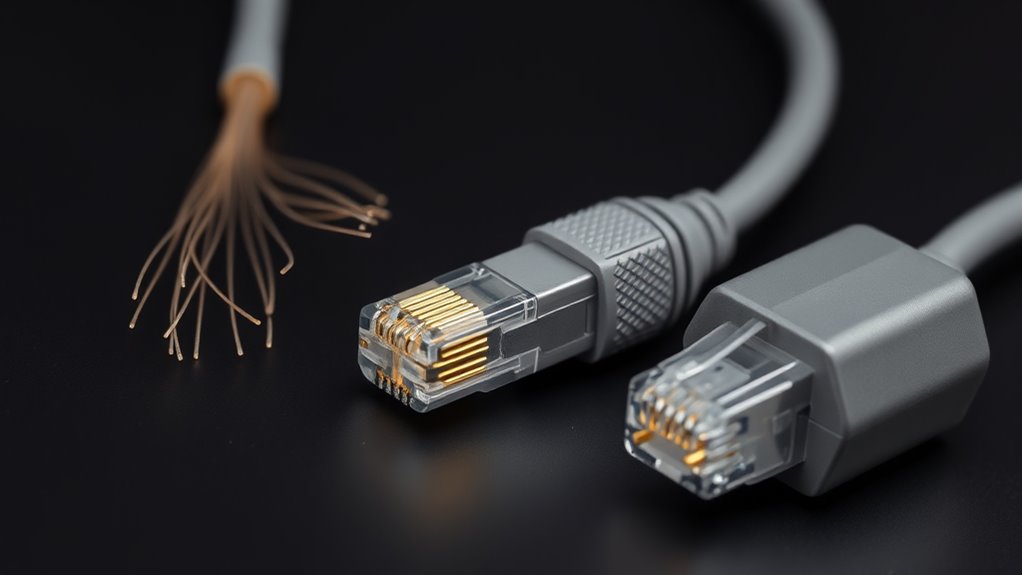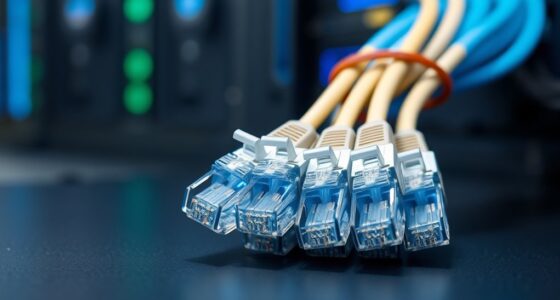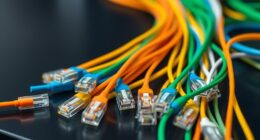When deciding between Cat5e, Cat6, and Cat6a cables, you need to contemplate your current network needs and future plans. Each type offers different levels of performance and cost, making the choice more than just a matter of price. Understanding the strengths and limitations of each cable can help you make a smarter decision that balances budget with reliability. But how do you determine which one fits your specific situation?
Key Takeaways
- Consider your current internet speed; Cat5e suffices for speeds up to 1 Gbps, while Cat6 and Cat6a support higher performance.
- Budget constraints favor Cat5e, but investing in Cat6 or Cat6a offers better future-proofing and reduced signal interference.
- For large networks or demanding applications, higher categories like Cat6a provide enhanced bandwidth and longer cable runs.
- Installation complexity and costs increase with higher categories due to shielding and specialized connectors.
- Balance your immediate needs and future growth to choose the most cost-effective and scalable cable category.

Are you unsure which Ethernet cable suits your needs best? Choosing the right cable depends on understanding how each type impacts your network speed and installation costs. If you’re setting up a home office or upgrading your current system, these factors can make a big difference in your decision-making.
Start by considering network speed. Cat5e cables are the most basic option, supporting speeds up to 1 Gbps over distances up to 100 meters. They’re suitable for everyday browsing, streaming, and light gaming, but if you need faster data transfer rates or future-proofing, they might fall short. Moving up, Cat6 cables can handle speeds up to 10 Gbps, but only over shorter distances—around 55 meters—making them ideal for high-speed internet and data-intensive tasks within a home or small office. If you want even more bandwidth and better performance with less interference, especially in crowded environments, Cat6a cables are your best bet. They support up to 10 Gbps at lengths up to 100 meters, ensuring you’re prepared for demanding applications and larger networks.
Consider Cat5e for basic needs, Cat6 for high-speed tasks, and Cat6a for maximum performance and future-proofing.
Installation costs are another critical factor. Cat5e cables are generally the most affordable, both in terms of material and installation, because they’re simpler to work with and widely available. If you’re on a tight budget and your network demands are modest, they’re a cost-effective choice. However, if your setup requires higher performance, investing in Cat6 or Cat6a can be worthwhile. The slightly higher price of these cables reflects their improved shielding and construction, which help reduce crosstalk and signal degradation. Keep in mind that installation costs can also increase if you need to run cables through walls or ceilings, especially with Cat6a, which often requires more careful handling and potentially more expensive connectors and accessories. Additionally, understanding the importance of bandwidth in your network setup can help you make a more informed choice.
Ultimately, your choice hinges on balancing current needs with future growth. If your internet plan offers speeds below 1 Gbps and you don’t anticipate upgrading soon, Cat5e might suffice. But if you’re aiming for faster speeds, better reliability, and more longevity, investing in Cat6 or Cat6a makes sense despite the higher upfront costs. Remember, the right Ethernet cable can improve your network’s performance while saving you money and hassle in the long run.
Frequently Asked Questions
How Does Cable Shielding Affect Performance and Interference?
Cable shielding reduces electromagnetic interference, helping your signals stay clear and strong. When shielding is added, it prevents external noise from disrupting data transmission, which enhances signal integrity. This means you experience fewer data errors and faster, more reliable connections. If you’re in a high-interference environment, shielded cables are a smart choice because they protect your network from external electrical noise, ensuring your data stays accurate and your network runs smoothly.
Can These Cables Be Used Outdoors Safely?
You can use Cat5e, Cat6, and Cat6a cables outdoors safely if they’re rated for outdoor durability and weather resistance. Look for cables with a protective jacket designed to withstand moisture, UV rays, and temperature changes. These features guarantee your cables stay functional despite exposure to the elements. Always check the product specifications for outdoor use, and consider additional protective conduits for long-term outdoor installations.
What Are the Installation Differences Among the Cable Types?
Think of installation like laying a track for a smooth ride. You’ll find that Cat5e cables are easier to install, with simpler techniques and compatible connectors. For Cat6 and Cat6a, you’ll need to follow more precise installation techniques, such as careful cable management and using the right connectors to prevent interference. These differences guarantee ideal performance and durability, making your setup reliable whether you’re running short or long distances.
How Do Future Network Upgrades Impact Cable Choice?
Future network upgrades, like adding fiber optic connections or supporting higher Power over Ethernet (PoE), influence your cable choice. Opting for Cat6a provides better bandwidth and future-proofing for increased data speeds and PoE power demands. If you anticipate fiber optic integration or higher power needs, choosing higher-grade cables guarantees your infrastructure can handle upcoming technology, reducing costly upgrades later. This way, you’re prepared for evolving network requirements.
Are There Eco-Friendly or Sustainable Options Available?
You can find eco-friendly options by choosing cables made from sustainable materials, such as recycled plastics and environmentally conscious insulation. Some manufacturers now produce cables with reduced environmental impact, supporting your sustainability goals. Look for certifications like Green Seal or RoHS compliance, which guarantee the cables meet eco-friendly standards. These options help you minimize your carbon footprint while maintaining reliable network performance, making your setup both eco-conscious and future-proof.
Conclusion
Ultimately, choosing between Cat5e, Cat6, and Cat6a comes down to matching your needs with your budget, balancing basic tasks with future demands, and weighing cost against performance. If you want affordability, go with Cat5e. If you need speed for high-performance tasks, choose Cat6. For maximum reliability and future-proofing, select Cat6a. By evaluating your current use, planning for future growth, and considering your investment, you’ll make the best choice for your network.









